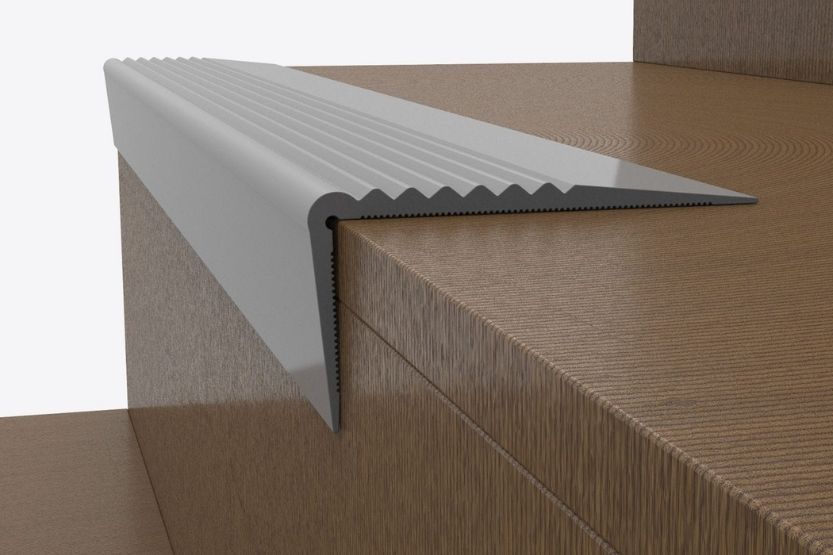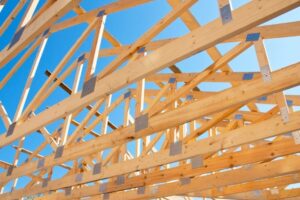Stairs come in various forms. Building a basic stairway might seem to be an easy task. But the fact is that several restrictions, calculations, and regulations have to be considered. These would include the width, length, and height of certain staircase parts. Not the least of which is the standard rise and run for stairs.
Building codes generally advise that the rise of a stair should have a standard maximum height of 7 3/4 inches, while the length of a tread or run should be at least 10 to 11 inches. Other factors to consider include headroom height, landing width, stringer length, and staircase lighting.
Read on to learn more about the standard rise and run for stairs.
Standard Rise and Run for Stairs

According to building codes, the rise of a stair should generally have a standard maximum height of 7 3/4 inches. At the same time, the length of a tread or run should be at least 10 to 11 inches. Aside from these, there are also other factors to consider. These are the headroom height, landing width, stringer length, and even the staircase lighting.
Importance of Standard Staircase Code Measurements
When building a staircase, crucial stair measurements such as their standard width, height, and depth should not be left to guesswork. The required staircase measurements are established by common practice and mandated by building codes.
Intended to Ensure Safety
These regulations are intended to ensure that staircases are safe for use and should never be taken for granted.
Build According to the Regulation
That being said, staircase code measurements do make certain allowances since measurements usually come with maximums or minimums. For instance, staircase codes dictate that the minimum standard stair width is three feet wide. As long as you’ve met the three-foot width requirement, you can build the stairs as wide as you want.
Helps Build a Comfortable and Durable Staircase
The recommended stair standards don’t just help you build a safer staircase. But it also provides a comfortable and durable one that you can use for years. Of course, staircase measurements may vary in other parts of the country. Many adopt the International Building Code (IBC), while others modify.
Required to Follow Local Building Code to Pass Inspections
Ensure to consult your local permitting agency to determine what codes apply in your area. But for the most part, you are required to follow the local building code to pass inspections.
The staircase code measurements we will discuss in this article apply to straight-run stairs. Spiral stairs and winding stairs adhere to different sets of code requirements.
Standard Staircase Rise and Riser
The term “rise” can refer to two things on the standard rise for stairs. These are the staircase height or the staircase riser:
Standard Staircase Rise (Height)
Refer to the Overall Staircase Height
First, the rise may refer to the overall height of the entire staircase itself. This starts from its lowest point to its highest. It is an important measurement to determine the location and placing of the landing.
No Code per Se for the Staircases’ Height or Length
Since each staircase is different and depends on the height of the floor, there is no code per se for the height or length of a staircase rise. However, fire safety codes mandate that there must be a landing for every 12′ (365.8 cm) to 12′ 3″ (147 inches) of rise.
Required to Have a Landing or Floor Level
Stairs should have a landing or floor level to break up the flight of stairs. If the distance between landings is more than 147 inches, the stairs will be required to have a level landing in-between the flight to break them up.
Standard Staircase Riser
The second rise or riser is the back, vertical section of a step.
The staircase’s height riser translates to the distance your feet travel from one point to another. Building codes prescribe that the standard maximum height of a rise should be 7.75 inches (19.7 cm).
The riser height is the vertical distance between two adjacent treads. As suggested by the building codes, the riser height should not exceed 7 3/4 inches. The risers must all be identical in height, with even the tallest riser not differing any more than 0.37 inches from the smallest one.
Risers may be allowed to slope from the tread’s underside up to 30 degrees. They can be open, solid, or come in any pattern. The important thing is that the spaces between steps are not large enough for a 4-inch-diameter sphere to pass through. This prevents little children from getting their heads stuck between the risers.
For residential high-rise buildings, the maximum riser height is 19 cm. For other buildings, the maximum is 15 cm, with a limit of 12 per flight.
Standard Staircase Run or Tread Depth
Part of the Stairs You Step on
The tread or run is the flat, horizontal part of the stairs you step on. The tread depth is measured from the front edge of one step’s nosing to the next one’s nosing.
Tread Depth Should Be at Minimum of Ten Inches
When you measure the tread depth horizontally, it should be at a minimum of ten inches (25.4 cm). But some steps don’t have nosings, and their risers are solid instead of open. In which case, the tread depth should be at least 11 inches.
Should Allow Room for Feet to Rest
Staircase risers need to be deep enough to allow enough room for most of your feet to rest on the step. Stair tread depth is more a matter of descending the stairs rather than ascending it.
Also, measuring the run of every tread in the stairway should be as close to identical as possible. The largest tread depth within a staircase should not be 3/8 inches greater than the smallest one.
Nosing Projection
The nosing’s projection should not be any more than 1 1/4 inches and not any less than 3/4 inch. The tolerance of the run or nosing should not be more than 0.37 inches. The maximum nosing projection should not be 3/8 inches larger than the smallest projection:
Again, what is the standard rise and run for stairs? According to the 2018 IBC building code, the maximum rise is seven inches, and the minimum tread depth is 11 inches. Meanwhile, according to OSHA, the standard rise and run are 9.5 inches. Lastly, the maximum rise is 12 inches.
Common Stair Terminology and Building Code Standards

About the topic, below is a list of common stairway terminology and the building code regulations that apply to each of them.
These include the following:
- Nosing
- Landing
- Headroom
- Lighting
- Staircase Width
- Handrails and Guards or Guardrails
- Stringer
1. Nosing
Nosing is the protruding edge of the tread overhanging the riser below. Its main function is to improve safety by providing additional space to place their feet. While some steps do not have a nosing, it is included in the tread length when it is present.
Building codes recommend a nosing length of 0.75 inches (1.9 cm) at a minimum and 1.25 inches (3.2 cm) at maximum.
2. Landing
A requirement in every staircase, the landing refers to the approach space at the top and bottom of the stairs and the platform in-between two flights of stairs. The width of the landing is measured perpendicular to the travel direction.
It must not be less than the staircase’s width. Its minimum depth, measured likewise in the direction of travel, should be 36 inches.
3. Headroom
The height from the top of the stair tread to the ceiling directly above it is the headroom. Headroom building codes are intended to ensure sufficient room for people to use the stairs comfortably. But they usually require much more room than a person’s average height to move larger objects. This includes bringing furniture up the stairway.
When you measure it from an imaginary sloping line connecting all of the stair nosings, a staircase should have minimum headroom of 6 feet 8 inches (203.2 cm).
4. Staircase Lighting
All straight-run staircases are required to have their treads and landings illuminated by an artificial light source of not less than 11 lux. This is about as bright as a 1-foot candle. There should be a wall switch at every floor level for a staircase with six or more risers to switch the light source on and off.
5. Width
The staircase width refers to the side-to-side length if you’re ascending or descending the stairs. It also refers to the length of the risers and the treads measured from side to side.
Length measurements are typically longer than width measurements when considering rectangles. But the width is usually longer in the case of steps. According to building codes, the minimum stair width should be 36 inches (91.44 cm), not including the handrails.
6. Handrails and Guards or Guardrails
The handrail is the railing running up a stair incline. You can hold on to it when going up or down a staircase. The guard is a barrier alongside the stairs that prevents the person walking on it from falling to the lower level. Guards can come in the form of walls, half-walls, or benches. A guardrail is a guard that comes with rails.
Building codes usually require stairs with a total rise exceeding 30 inches above the floor to have a guard. This guard should measure a minimum height of 34 inches (86,36 cm) from the top of the treads. Measured in the same manner, rails should be between 34 to 38 (96.52) inches in height, with a diameter from 1.25 inches (3.18 cm) to 2.675 inches (6.79 cm).
7. Stringer
The stringer is the sawtooth-shaped structural member supporting the staircase’s rises and treads.
There are usually three stringers in a staircase—one on each side and another in the middle. While not always visible, stringers can be seen on stairs with open sides. They can either be cut in the shape of each step or occasionally uncut and conceal the tread’s edges.
Some utility stairways, like basement or deck stairs, do not employ sawtooth stringers. But instead, use a solid side stringer design that anchors the treads with metal connectors.
Tips on How You Can Calculate the Stairway’s Rise and Run

A couple of calculations can help you determine if your staircase’s rise and run will be comfortable to use.
Add the Total Length of the Riser to the Run or Tread Width
Adding the total length of the riser to the run or tread width (r + R) should yield a sum of about 18 inches with a deviation of not more than 1 inch. Also, two times the rise added to the run (2r + R) would equal 25 inches, again with a one-inch deviation.
It is helpful to refer to these calculations when considering a stairway’s comfort. For instance, a staircase with a rise and run of eight inches each won’t be comfortable. This is because its treads are too narrow for a person’s feet to fit on completely.
Using the given calculations, you will note that the rise and run’s total sum is 16, making it much too low for the first equation. On the other hand, the staircase would measure up to the second equation. This then gives a result of 24.
Acceptable Measurements According to Building Safety Regulations
In contrast, building safety regulations suggest that a five-inch-high, 13-inch-long stair may be acceptable. The rise plus the rum would give a sum of 18, which adheres to the ideal measurement of the first calculation. But it would be somewhat uncomfortable since twice the rise plus the run will equal 23.
When you apply said calculation to the standard rise of 7 inches and the standard run of 11 inches, you will get a total sum of 18, while the second gives a result of 25. Therefore, the standard staircase rises and runs perfectly meets both equations’ requirements.
Conclusion – Standard Rise and Run for Stairs
According to building codes, the rise of a stair should generally have a standard maximum height of 7 3/4 inches. At the same time, the length of a tread or run should be at least 10 to 11 inches. Aside from these, there are also other factors to consider. These are the headroom height, landing width, stringer length, and even the staircase lighting.
Rules are meant to be followed. The building code staircase regulations are set to ensure that a stairway is safe to walk on. Improperly-built stairs can mean the difference between life and death. So always follow the standard measurements and requirements when constructing a staircase.





![Read more about the article Pine-Sol and Bleach [Can You Mix Them?]](https://homecarezen.com/wp-content/uploads/2021/03/Pine-Sol-and-bleach-300x200.jpg)
